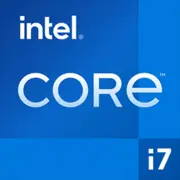Intel Core i7-10875H

インテル Core i7-10875H: 薄型プロセス時代のコメットレイクの力
2025年4月
1. アーキテクチャとプロセス技術: 5nmの世界における14nm
2020年に発売されたインテル Core i7-10875Hは、コメットレイク-Hファミリーに属し、中価格帯のノートパソコンで依然として見かけられます。2025年には5~7nmプロセス技術のチップが主流であるにもかかわらず、このモデルは価格と性能のバランスにより依然として需要があります。
コア、スレッド、周波数
- 8コア、16スレッド — 現在でもマルチタスクにおいて時代遅れとはならない構成です。
- ベースクロック: 2.3GHz、ターボモードでの最大クロックは5.1GHz(1コア)。全コアは4.3GHzまでオーバークロック可能です。
- 16MB L3キャッシュ — ゲームやプロフェッショナルアプリケーションでの待機時間を最小限に抑えるために十分な容量です。
統合グラフィックス
内蔵GPUはIntel UHD Graphics 10世代(24 EU、1.15 GHz)です。次の用途に適しています:
- 4Kでの動画視聴。
- オフィスプログラムでの作業。
- 軽いゲーム(例えばCS:GOやDota 2を30〜40FPSで)。
アーキテクチャの特徴:
- DDR4-2933メモリのサポート。
- Thunderbolt 3(外部ストレージやモニターに対応)。
- PCIe 4.0の不在 — これにより、最新のノートパソコンにおけるSSDの速度が制限されます。
2. TDP 45W: 熱的課題
プロセッサの公称TDPは45Wですが、ターボモードでは90〜100Wに達することがあります。これには次のものが求められます:
- 2〜3つのファンと熱管を備えた効率的な冷却システム。
- 定期的なホコリのクリーニング(特にゲーミングノートパソコンにおいて)。
適切な冷却を備えたノートパソコンの例:
- MSI GP66 Leopard(2025年の価格:$900〜1100)。
- Dell G5 15 SE($850〜1000)。
3. 性能: ターボモードと現実
オフィスとマルチメディア
- Chromeで20以上のタブを起動 + ストリーミング動画 + Excelで作業 — i7-10875Hにとって負荷は問題ではありません。
- Premiere Proでの4K動画レンダリング: Core i7-10750H(6コア)よりも20〜25%高速です。
ゲーミング
ディスクリートGPU(例えばRTX 3060)と組み合わせた場合:
- Cyberpunk 2077: 高設定(1080p)で60〜70FPS。
- Shadow of the Tomb Raider: ウルトラ設定(1080p)で90〜100FPS。
重要: ターボモードではプロセッサがすぐに加熱し、薄型ケースではサーマルスロットリングが発生する可能性があります。
4. 使用シナリオ: 誰に向いているのか?
- ゲーマー: 強力なGPUと優れた冷却システムと組み合わせることが必要です。
- デザイナー/エンジニア: AutoCAD、Blender、Photoshopで作業するために。
- ストリーマー: 8コアはOBSでのビデオエンコーディングにもFPSの落ち込みなしで対応できます。
推奨しない対象:
- ウルトラブック(TDPのために)。
- 6時間以上のバッテリー寿命を重視するユーザー。
5. バッテリー寿命: 力の代償
アクティブな使用時(ゲーム、レンダリング)はバッテリーの持ち時間が2〜3時間。オフィスモード(明るさ50%、Wi-Fi使用)では4〜5時間です。
省エネ技術:
- Intel Speed Shift: 周波数の動的管理。
- Cステート: 使用されていないコアのオフ。
アドバイス: バッテリー寿命を延ばすために、電源設定でターボモードをオフにしてください。
6. 競合との比較
AMD Ryzen 7 5800H (2021年)
- 利点: 7nmプロセス、マルチスレッド性能が優れる(Geekbench 6 Multi Core ~7200)。
- 欠点: ノートパソコンの価格が高い($1000〜1300)。
Apple M2 (2023年)
- + 最大18時間のバッテリー寿命、冷却性能の優れた動作。
- – Windowsプログラムとの互換性が限られている。
Intel Core i7-12800H (Alder Lake, 2022年)
- + シングルスレッドタスクでの性能が30%向上。
- – このプロセッサを搭載したノートパソコンは$1400から。
7. Core i7-10875Hの利点と欠点
利点:
- 高いシングルスレッド性能(Geekbench 6 Single Core 1494)。
- アフォーダブルなノートパソコン価格($800から)。
- Thunderbolt 3のサポート。
欠点:
- 古くなった14nmプロセス。
- 負荷時の加熱。
- PCIe 4.0の不在。
8. このプロセッサを搭載したノートパソコンの選び方
- ゲーミングモデル: RTX 3060以上のGPU、最低16GBのRAMを搭載したオプションを探してください。
- ワークステーション: 1TBのSSDと100% sRGBカバーの画面が必須です。
- 避けるべき:ウルトラスリムケース — 冷却に対応できません。
2025年の成功モデルの例:
- Acer Nitro 5($850〜950):価格と性能のバランス。
- HP Omen 15($950〜1100):セグメント内での優れた冷却。
9. 総括
Intel Core i7-10875Hは2025年において、以下のような人々に適した選択肢です:
- ゲームやグラフィック作業といった安価なノートパソコンを求める人。
- 最新のプロセッサに対して価格を支払う準備がない人。
- 加熱や平均的なバッテリー寿命を受け入れられる人。
主な利点: ほとんどのタスクに対するパフォーマンス、現代的なソフトウェアとの互換性、手ごろな価格。エネルギー効率や「新しい」プロセス技術が重要であれば、AMD Ryzen 5 7640HSやIntel Core i5-13420Hを検討してください。
基本
CPUの仕様
メモリ仕様
GPUの仕様
その他
ベンチマーク
他のCPUとの比較
ソーシャルメディアで共有する
または当サイトへのリンクを追加
<a href="https://cputronic.com/ja/cpu/intel-core-i7-10875h" target="_blank">Intel Core i7-10875H</a>